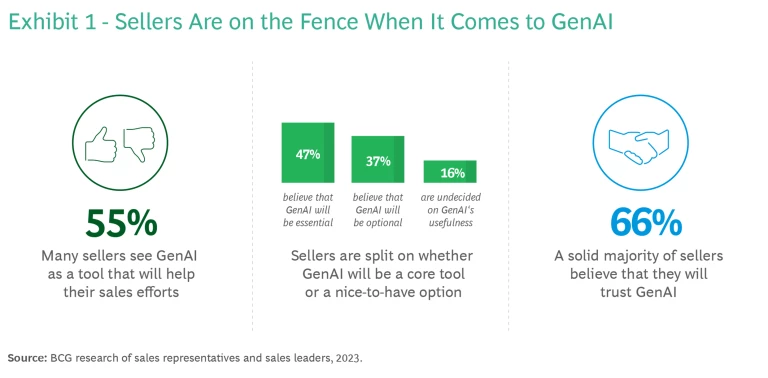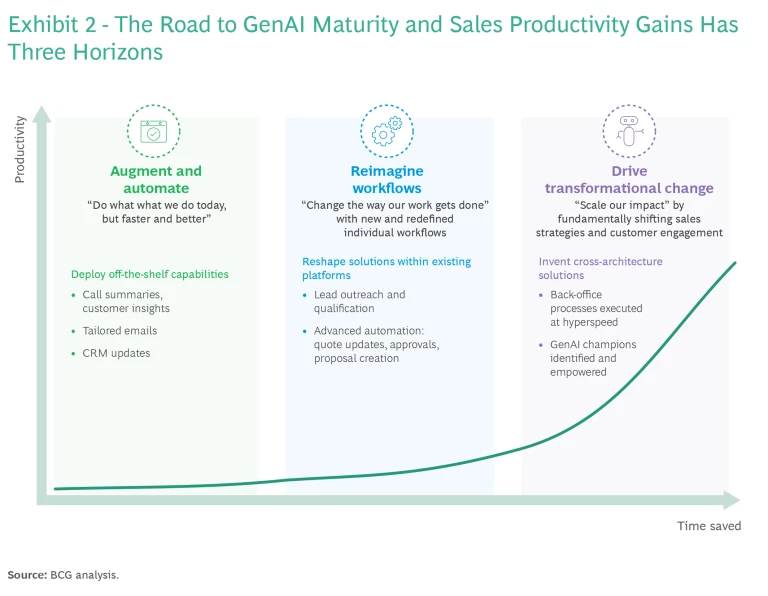Seizing new market opportunities, personalizing customer engagement, selling more effectively, executing back-office activities at lightning speed—these are the opportunities that generative AI (GenAI) will unlock for B2B sales executives. Fully accessing this exponential increase in value does not happen overnight, but with the right approach it can happen fast, delivering tangible benefits to sales teams.
To help organizations get on the right track, BCG has developed an approach to transforming their go-to-market (GTM) function by harnessing GenAI at scale and on pace. Structured along three horizons, our framework serves as a guide for enterprise-wide use of GenAI to augment the reach of sales teams, automate tasks intelligently, reimagine processes and workflows, and transform GTM functions. This approach enables organizations, from the outset, to build the seller trust that is a prerequisite for reaping immediate seller productivity benefits when leveraging new capabilities within existing sales technologies and processes. At the same time, it helps teams develop the skills needed to work with GenAI personas (digital team members that imitate human behavior) as key enablers of their GTM sales strategies.
In an earlier article , we highlighted the promise and the power of GenAI for B2B sales teams and the vital importance of building seller trust. Here, we look at how organizations can get started on their GenAI journey, and we outline the steps that leaders can take to set their organization on a path to AI maturity. By identifying areas of value, piloting GenAI capabilities, and scaling pilots with proven impact, organizations can use our three horizons to capture value in the near term while moving along a path toward a longer-term transformation of B2B sales.
The Road to New Value
The enthusiasm for GenAI among B2B sales organizations is becoming clear. BCG research has found that more than 70% of sales leaders plan to invest in GenAI. And according to Salesforce, almost 70% of tech leaders have prioritized GenAI over the next 18 months.
But while the vast majority of sellers who already use GenAI—84%, according to Salesforce—say it helps increase sales by enhancing or speeding up customer interactions, over 50% of sellers say they are still unsure about how to take full advantage of the technology. Sales organizations need to overcome the adoption challenges that they faced in previous iterations of AI. BCG research has found that over 75% of sales organizations have invested in AI and sales analytics, but only 20% have fully adopted the technology, and 45% believe they could have done better.
It is therefore critical to help sales teams become comfortable with using GenAI, which works more independently than earlier versions of AI. It is also essential to develop processes and capabilities that enable sellers to deploy these solutions while ensuring that safety measures are in place to mitigate the risk of early attrition of supporters. (See Exhibit 1.)

Unlocking GenAI’s value faster requires combining new ways of thinking with a deep understanding of the unique ways in which B2B sales teams engage with AI. And since earlier iterations of analytics and AI worked less independently, it also means doing things differently. To maximize organizations’ chance of success, BCG has developed the following three-horizon framework. (See Exhibit 2.)

Augment and Automate: “Do What We Do Today, but Faster and Better"
In this first phase, sales organizations should deploy GenAI to augment their sales teams, helping sellers automate their tasks, which frees up more time to close more and bigger deals. Onboarding GenAI personas can help sales teams do more and see immediate benefits, which in turn promotes employee buy-in. In this horizon, GenAI personas keep the sellers at the center and act as expert assistants, helping them sell more effectively and reducing the time they spend on administrative activities.
66% of sales reps believe GenAI will make them more productive.
GenAI personas can perform numerous tasks. For example, a sales assistant persona can update opportunities and account information to maintain data and customer relationship management (CRM) data hygiene. A dedicated data scientist persona can help sellers prepare for customer conversations by surfacing relevant insights and contact intelligence. A personal marketer persona can help sellers tailor customer engagement through pre-written emails and bespoke content. And a sales coach persona can provide actionable guidance on how sellers can close more deals faster.
Organizations that succeed in using GenAI to automate tasks and augment their sales teams have several things in common:
- They don’t let pursuit of perfection kill progress—they just get started. To do so, they harness technology that is already available within their existing processes and systems architecture. For example, off-the-shelf capabilities available from Salesforce include the call summaries and deal insights made possible by Einstein Co-Pilot (a conversational AI assistant built into Salesforce), which is easy to deploy within existing workflows, giving sales teams immediate benefits of GenAI personas without changing their existing work patterns. Other CRM providers such as Microsoft are building similar capabilities into their roadmaps.
- They put change management at the core of the rollout, and they focus from the outset on building trust with sales users by involving them in the design process, listening to their feedback, and targeting pain points that pose the greatest obstacles to effectively doing their jobs.
- They focus on the data and use initial rollouts to determine where more or better data is needed to support use cases and how to improve data capture from sales users, increasing the utility of data in core systems like CRM.
Sellers and sales leaders see challenges related to accessing high-quality data as the biggest obstacle to taking full advantage of GenAI.
For companies that are harnessing off-the-shelf capabilities, the “augment and automate” phase is already delivering positive results, such as faster and better call summaries and meeting preparations. One BCG client, for example, experienced a 20% reduction in customer call handling time, which freed up teams for four more hours of customer-facing work time per week. “Augment and automate” is the first step on the path to unlocking value through GenAI by creating additional, higher-quality time with customers. The next step is to advance from improving specific tasks to fully reimagining workflows.
Reimagine Workflows: “Change the Way Our Work Gets Done”
GenAI personas enable organizations to execute more complex processes, reimagining the workflow across teams and systems to streamline processes and complete work more quickly. Organizations can configure fit-for-purpose solutions within existing CRM platforms that take advantage of combinations of the core CRM system, data, and AI capabilities available within their ecosystem, augmented by custom development on adjacent platforms where needed. Reimagined workflows can deliver significant benefits in various ways:
- They can significantly expedite configure-price-quote processes by using GenAI sales support personas to anticipate customer proposal needs and create options in advance, reducing friction between sellers and deal desks.
- They can enable GenAI to conduct initial outreach on behalf of the seller, increasing qualification at scale, reducing the amount of time sellers must spend on prospecting, and making it easier to funnel the warmest leads to sales for progression.
- They can generate request-for-proposal (RFP) responses that greatly increase bid volume and improve bid quality by ensuring that all requirements are met.
Organizations should keep several key considerations in mind as they reimage their workflows with GenAI:
- GenAI blurs the lines between functions such as marketing and sales . Since GenAI personas can execute a targeted campaign and engage customers in initial chats, organizations need to ensure that GenAI supports the overall commercial objectives and without getting trapped in organizational silos.
- This is fundamentally a business transformation, not a tech transformation. It is not a case of simply automating what exists today. The GenAI transformation provides an opportunity to rethink how things are done, creating more moments of value add and fewer of operational drag.
- Sellers need to reskill in order to partner with AI effectively. BCG research shows that sales leaders view seller competencies as a core challenge of leveraging GenAI, and over half (51%) of sellers believe that reskilling is necessary to partner effectively with GenAI. Teams require training on how to best work with AI as the technology’s role within their workflows expands.
For example, one BCG client is working on a complete transformation of its RFP response process. Using a GenAI solution that both reads and responds to RFPs, the organization aims to increase the number of RFPs it can respond to by 60% and to eliminate the need for a dedicated RFP response team to cover its lower customer tiers. Now it is starting to look beyond this workflow structure to the larger goal of transforming its entire sales operations function.
Drive Transformational Change: “Scale Our Impact”
With GenAI at the core of their workflows, organizations can transform functions to give every sales strategy and channel greater scale and reach. With the ability to create and execute, GenAI can enable sales organizations to replicate the outcomes of their best sales teams at a scale not previously imagined, fundamentally changing how organizations think about the markets they target. Using the power of AI to transform the GTM function enables organizations to break down silos as GenAI personas begin to engage customers across their life cycle.
Before they can harness the exponential impact that GenAI makes possible, organizations may need reimagine their organizational and operating models, including the demarcation between marketing, sales, and service functions. They must build or adapt their technology architecture as the transformative impact of AI moves across functional boundaries and extends beyond the frontiers of existing platforms. They must test innovative use cases at speed. And they must manage both internal and external risks. Internally, to avoid creating new silos around the technology, it is essential to provide human support in an optimized human + AI operating model. Externally, mechanisms must be in place to protect the organization from the brand risk posed by the direct engagement of AI with customers and partners.
It is too early in most sales organizations’ GenAI journeys to provide examples of these types of transformations. But if previous disruptive innovations in sales such as e-commerce and product-led growth are anything to go by, first movers will gain significant advantage. This makes it critical for organizations to move swiftly to get started on their GenAI journey.
Three Steps to Getting Started
At the outset, organizations should consider taking three key steps.
Prioritize the highest-value, lowest-friction uses cases. In identifying the highest-value use cases to make sales teams more productive, organizations must ask several questions: What can be automated? Where are teams searching for information that should be curated for them? Where are they spending time logging or documenting information instead of selling? Organizations should also deploy off-the-shelf capabilities to augment team capabilities and automate tasks within sales workflows in CRM systems.
Build your team’s innovation muscles. Organizations should pilot capabilities, measure value, iterate, and scale, all while keeping sales teams involved and at the heart of the process. GenAI champions can prove the technology’s value and build what is most useful to them. Harnessing their enthusiasm can help bring along the skeptics.
Create an audacious vision of the future. In parallel with the first two steps, leaders should define an end-state vision for the organization. What boulders must be moved to create a step-change in productivity? This thinking is key to developing a more transformational vision.
GenAI is evolving rapidly. As Canadian prime minister Justin Trudeau put it, “the pace of change has never been this fast, yet it will never be this slow again.” As it applies to the GenAI strategies of sales organizations, this comment suggests that, before long, new tools will emerge that are a dramatic improvement on what is available today.
We believe it would be unwise to wait even that short time. Organizations can get ahead of the value game now by using GenAI to reach more customers faster and better and by reaping the immediate benefits of making organizations GenAI-friendly, GenAI-fluent and, ultimately, GenAI-centered. With GenAI at the heart of sales teams, the humans working with it will themselves be empowered to do more—and to do it better and faster.











